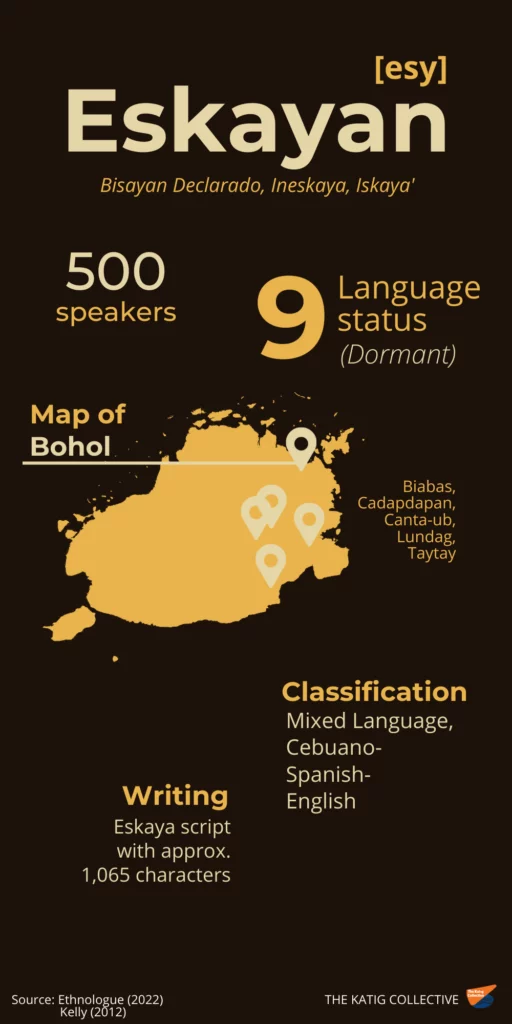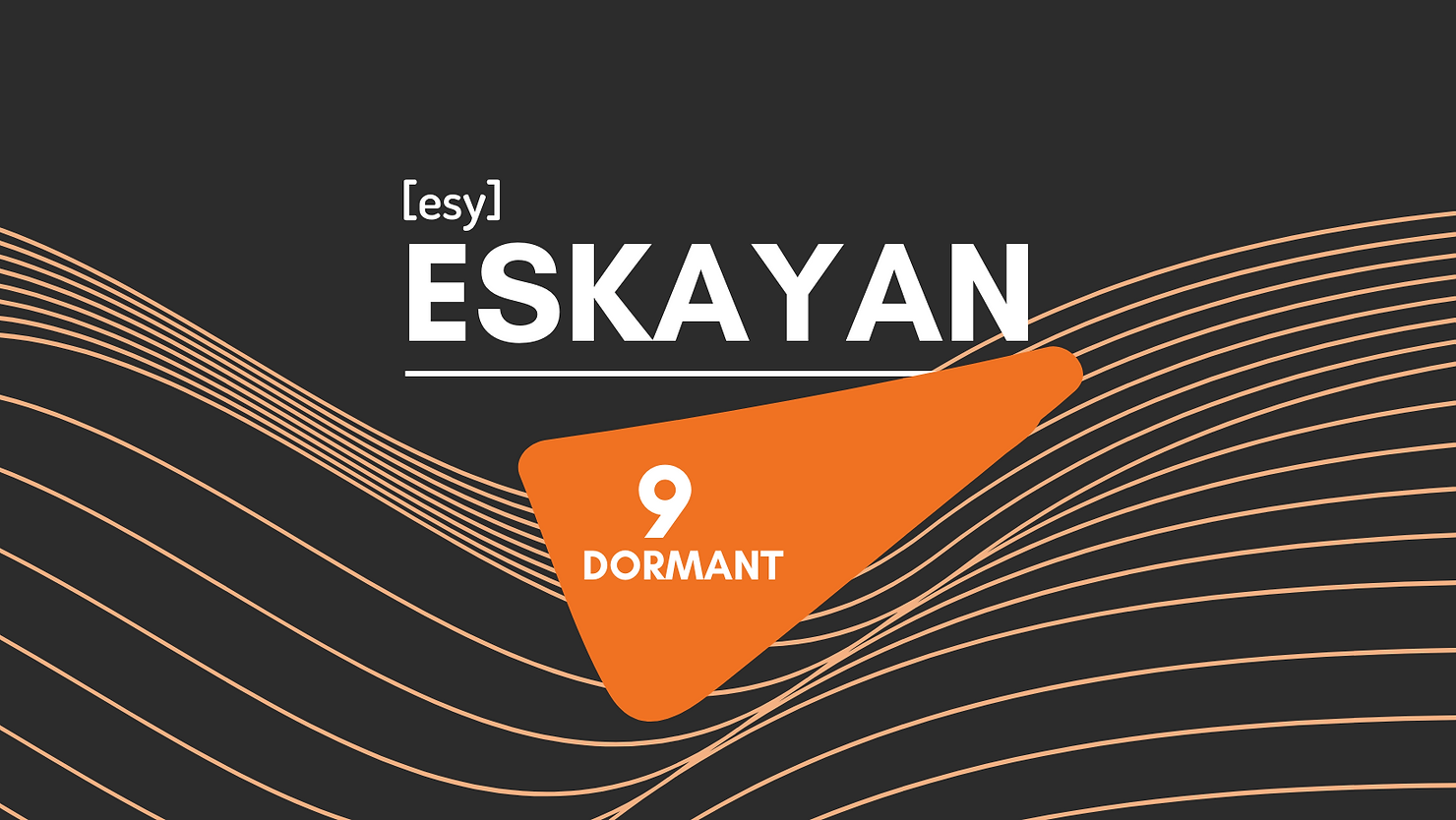Eskayan
With around 500 speakers left, all of whom do not speak the language as their mother tongue, Eskayan [esy] seems to be facing extinction (Eberhard et al., 2022). Eskayan is considered dormant (EGIDS 9), a language that only “serves as a reminder of heritage identity for an ethnic community, but no one has more than symbolic proficiency” (Eberhard et al., n.d.), used mostly in religious and political events. The people passing the knowledge down to the younger generations are volunteers, and the natives prefer to use the more dominant lingua franca in education, work, and trade. The language is thus relegated to fewer domains and could be completely replaced.

Origin, history, features
Eskayan is spoken by the Eskaya people, a small group residing in the towns of Biabas, Cadapdapan, Canta-ub, Lundag, and Taytay in Bohol (Eberhard et al., 2022). Their status as indigenous people is still up for discussion partly because their history is entangled with folklore, religion, and rumors (Logarta, 1981; Echeminada, 1989; Abregana, 1985; Tirol, 1991). Legends tell of Pinay, an ancestor of the Eskaya and the folkloric “first pope” in the Philippines (Bojos et al., 2016). Eskaya people believe that Pinay created the language and its complex writing system. This original language was lost but was found in the 20th century by the revolutionary Mariano Datahan. Geographical, cultural, and linguistic isolation, along with the curiosity for the mystic, prompted journalists and some academics to write about the Eskaya people and their language. It was during the 1980s when the people were “rediscovered” and origin theories were formulated and spread via the press.
It bears many structural similarities with Boholano, a dialect of Cebuano [ceb] and it has several possible loan words from Cebuano, Spanish [spa], and English [eng] (Eberhard et al., 2022). Kelly (2012a) characterizes Eskayan as an engineered language constructed through relexifying Bisaya or Cebuano. Its simplit (‘syllabary’) has approximately 1,065 characters, and the letters resemble human body parts and poses (Kelly, 2012b).
Works about Eskayan
Linguist Piers Kelly (2006) compiled a wide range of primary texts, multimedia resources, and other materials on the Eskayan language, and this collection is available online at PARADISEC. Some of his writings discuss Eskayan history and context (2012b; 2016a), morphosyntax (2012a), phonotactics (2015), and writing system (2016b). His most recent publication (2021) is an ethnographic history of the language and the people.

References
Abregana, B. S. (1985, March 12). Open letter to Governor Rolando Butalid G.
Bojos, S. T., Pacaña, N. M. S., Ramos, C. D., Inocian, R. B., & De la Torre, N. P. (2016). Demystifying the magic of Eskaya writing system in Duero, Bohol, Philippines. Asia Pacific Journal of Multidisciplinary Research, 4(1), 60-71. http://www.apjmr.com/wp-content/uploads/2016/03/APJMR-2016.4.1.08.pdf
Eberhard, D. M., Simons, G. F., & Fennig, C. D. (Eds.). (n.d.). Language status. Ethnologue: Languages of the world. https://www.ethnologue.com/about/language-status
Eberhard, D. M., Simons, G. F., & Fennig, C. D. (Eds.). (2022). Eskayan. Ethnologue: Languages of the world (25th ed.). https://www.ethnologue.com/language/esy
Echeminada, P. (1989, March 1). Ancient tribe in Bohol draws savants, psychics. The Philippine Star, 3.
History Asia. (2016, November 18). Mysterious tribal village of Eskaya, Philippines | Ride N’ Seek Philippines S4 [Video]. YouTube. https://www.youtube.com/watch?v=ps8–n7vN7s
Kelly, P. (Collector). (2006). The Eskayan digital archive. Collection PK2 at PARADISEC Catalog. https://dx.doi.org/10.4225/72/56E978E167AB2
Kelly, P. (2012a). The morphosyntax of a created language of the Philippines: Folk linguistic effects and the limits of relexification. In M. Ponsonnet, L. Dao & M. Bowler (Eds.), Proceedings of the 42nd Australian Linguistic Society Conference – 2011 (pp. 179-223). Australian National University. http://hdl.handle.net/1885/9401
Kelly, P. (2012b). Your word against mine: How a rebel language and script of the Philippines was created, suppressed, recovered and contested. The Australian Journal of Anthropology, 23(3), 357-378. https://onlinelibrary.wiley.com/doi/full/10.1111/taja.12005
Kelly, P. (2013). The word made flesh: An ethnographic history of Eskayan, a utopian language and script in the southern Philippines [Unpublished dissertation]. Australian National University. 10.25911/5d5147de68750
Kelly, P. (2015). A comparative analysis of Eskayan and Boholano-Visayan (Cebuano) phonotactics: Implications for the origins of Eskayan lexemes. Journal of the Southeast Asian Linguistics Society, 8, iii-xiv. http://hdl.handle.net/1885/14914
Kelly, P. (2016a). Excavating a hidden bell story from the Philippines: A revised narrative of cultural-linguistic loss and recuperation. Journal of Folklore Research, 53(2), 86-113. https://doi.org/10.2979/jfolkrese.53.2.04
Kelly, P. (2016b). Introducing the Eskaya writing system: A complex messianic script from the southern Philippines. Australian Journal of Linguistics, 36(1), 131-163. https://doi.org/10.1080/07268602.2016.1109433
Kelly, P. (2021). The last language on Earth: Linguistic utopianism in the Philippines. Oxford University Press.
Logarta, M. T. (1981, September 5). The Eskaya cult: Children of a lost language. Who (pp. 22-27). n.p.
Open Language Archives Community. (n.d.). OLAC resources in and about the Eskayan language. http://www.language-archives.org/language/esy
Tirol, J. B. (1991). Eskaya of Bohol: Traces of Hebrew influence paving the way for easy Christianization of Bohol. Bohol’s Pride (pp. 50-51). n.p.

